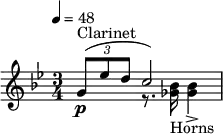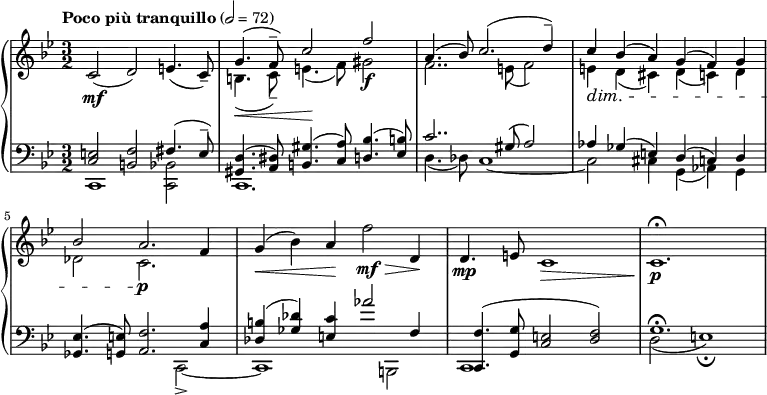Symphony No. 5 (Prokofiev)
Sergei Prokofiev wrote his Symphony No. 5 in B-flat major, Op. 100, in Soviet Russia in one month in the summer of 1944.[1]
| Symphony No. 5 | |
|---|---|
| by Sergei Prokofiev | |
 Prokofiev, photographed in 1936 by Pierre Choumoff | |
| Key | B-flat major |
| Opus | 100 |
| Composed | 1944 |
| Duration | 40 min |
| Movements | Four |
| Premiere | |
| Date | January 13, 1945 |
| Location | Moscow Conservatory |
| Conductor | Prokofiev |
| Performers | USSR State Symphony Orchestra |
Background
Fourteen years had passed since Prokofiev wrote the first version of his Symphony No. 4 in C major.[2]
World War II was still raging during the symphony's gestation, and Prokofiev composed it in the Soviet Union. He gave out in a statement at the time that he intended it as "a hymn to free and happy Man, to his mighty powers, his pure and noble spirit."[3] He added "I cannot say that I deliberately chose this theme. It was born in me and clamoured for expression. The music matured within me. It filled my soul."
Movements
| External audio | |
|---|---|
| Performed by the Berlin Philharmonic under Seiji Ozawa | |
The piece is in four movements, lasting 40–45 minutes:
- Andante (in B-flat major)
- Allegro marcato (in D minor)
- Adagio (in F major)
- Allegro giocoso (in B-flat major)
Movement I
The first movement is in a tightly argued sonata form: its exposition presents two themes – one calm and sustained, the other soaring with tremolo accompaniment from strings – which are then involved in an elaborate and climactic development section. The movement is wrapped up with an electrifying coda, punctuated by a roaring tam-tam and low piano tremolos.
- 1st theme, mm. 1–7
![\relative c' { \clef treble \time 3/4 \key bes \major \tempo "Andante" 4 = 48 f4(\p^"Flute/Bassoon" g a8. f16 | c'8. bes16 f'4 bes | d,8. ees16 f4.) g8( | f ees d c bes c | ees4 d4.) bes8( | c[ ees d] bes'4 g8) | g8.( a16 f2~ | f4) }](../I/899a7d0f7024505572483f431745b4cf.png.webp)
- mm. 8–10

- mm. 29–30

- 2nd theme, mm. 54–64

- mm. 74–77

- Closing theme, mm. 83–86

Movement II
The second movement is an insistent scherzo in Prokofiev's typical toccata mode, framing a central theme in triple time.
- mm. 3–10
![\relative c'' { \clef treble \time 4/4 \key d \minor \tempo "Allegro marcato" 4 = 132 r8 bes(^"Clarinet"\mp a gis bes a d a | e' a,-- cis-- e-- a2->) | r8 a(\< aes g c4--) a--\! | f8.->(\f c16) c8-. c-. c-. c-. c-. c16^"Oboe/Viola"( d | b4-> bes16)[ r bes( c] a4->) aes-- | g8.->( c,16) c8-.\> c-. c-. c-. c-. c-.\! | \clef bass c(->\mf^"Cello"[ des)] bes(\>->[ c)] aes->([ bes)] g(-.[ aes->)\!] | f\mp-> }](../I/7b1791ffe67c9172d36728c400bf500e.png.webp)
- mm. 56–58

- mm. 112–115

- mm. 120–127

- mm. 154–157

Movement III
The third movement is a dreamy slow movement, full of nostalgia, which nevertheless builds up to a tortured climax, before receding back to dreaminess.
- mm. 4–8
![\relative c'' { \clef treble \time 3/4 \key f \major \tempo "Adagio" 4 = 60 f\p(_"espress." e) f8( e | d c d b c4~ | \time 4/4 c8] f([ a c] e a b, g' | \time 3/4 bes,4-- f'-- a,--~ | a8) }](../I/4442f646e3eb1cca1eb133f1a062db1f.png.webp)
- mm. 55–62

- mm. 82–84

- "tortured climax" mm. 125–131
![{ \new PianoStaff <<
\new Staff \relative c' { \clef treble \time 3/4 \key fis \minor \tempo 4 = 60 <cis' fis, b,>8.-> <fis fis,>16 <eis a,>8.-> <cis a>16 <d bes>8.-> <b cis, b>16 | <cis fis, b,>8.-> <fis fis,>16 <eis a,>8.-> <cis a>16 <d bes>8.-> <b cis, b>16 | <cis fis, b,>8.-> <fis fis,>16 <eis a,>8.-> <cis a>16 <d bes>8.-> <b fis b,>16 | \time 9/8 \key a \minor c'8.->(\ff[ bes16)] aes64([ g f ees d c b aes)] g4-> fis8-> f4.-> | c''8.->(\ff[ bes16)] aes64([ g f ees d c b aes)] g4-> fis8-> f4.-> }
\new Staff \relative c { \clef bass \time 3/4 \key fis \minor <fis, b,>8. <b g>16 <b g>8. <d' bes f>16 <d bes f>8. <fis,, b,>16 | <fis b,>8. <b g>16 <b g>8. <d' bes f>16 <d bes f>8. <fis,, b,>16 | <fis b,>8. <b g>16 <b g>8. <d' bes f>16 <d bes f>8. <d, d,>16 | \time 9/8 \key a \minor << { aes'8 c d g, b <d fis,> f, bes d | aes8 c cis d b fis eis b' cis } \\ { aes,4. b cis | aes4. b cis } >> } >> }](../I/8f25874e84f43228df167b833b895c17.png.webp)
Movement IV
The finale starts with a cello choir playing a slow introduction containing elements from the first theme of the first movement, which then launches into the movement proper, a rondo. The playful ("giocoso") main theme is contrasted with two calmer episodes, one played by the flute, the other a chorale on strings. At the end, just as the movement is striving to end in a victorious tone, the music unexpectedly degenerates into a manic frenzy (rehearsal mark 111), which is then interrupted by a string quartet playing staccato "wrong notes" (rehearsal mark 113) with rude interjections from low trumpets, making the ultimate orchestral unison on B-flat sound all the more ironic.
- mm. 3–6

- Theme from first movement, mm. 15–22

- mm. 29–36
![\relative c'' { \clef treble \time 2/2 \key bes \major \tempo "Tempo I" 2 = 72 \partial 8*1 f8\p(^"Clarinet" bes,4.-- c8-- d4.-- a'8-- | bes2.--) a16( g f g | a4.) bes16( c bes4.) d,8 | d2..-> e16( fis | g4.-> fis16 e d cis b a g8)[ r16 ges-.] | ges8-> aes'2.-- ges,8( | f4.-- ees8-- f'4.--) c16( ees | d8) bes'2.-- }](../I/07f5e6b248d118c87be91e42e63ba40a.png.webp)
- mm. 37–38
![\relative c'' { \clef treble \time 2/2 \key bes \major \tempo 2 = 72 \partial 8*1 d'16( f) | e,->[ e-. e-. e-.] e-.[ e-. f-. e-.] ees-.[ d-. des-. c-.] ces-.[ bes-. a-. cis-.] | aes,2.. }](../I/74032930b58b2bf7d8f7213a2b47a4bd.png.webp)
- mm. 54–55

- mm. 83–90

- mm. 164–172

Instrumentation
The work is scored for the following:
| Woodwind | Brass | Percussion | Keyboard
Strings
|
Premiere
The symphony was premiered on January 13, 1945, in the Great Hall of Moscow Conservatory by the USSR State Symphony Orchestra, conducted by Prokofiev himself.[4]
As he took the stage, artillery fired. He paused until it finished. This left a great impression upon the audience, who upon leaving the Great Hall learned the gunfire marked the Red Army's crossing of the Vistula into Germany.[4] The premiere was very well-received, and the symphony has remained one of the composer's most popular works.
Then, in November of that year, Serge Koussevitzky and the Boston Symphony Orchestra introduced the score to America and recorded it in Boston's Symphony Hall on February 6 and 7, 1946, for RCA Victor, using an optical sound film process introduced by RCA in 1941; it was initially issued on 78-rpm discs and later on LP and CD. The symphony's rapid insertion into the repertoire was referenced by Dennis Dobson in his review of the 1951 Edinburgh Festival for Music Survey, where he panned the work as "noisy, uncouth" and a "falling off in maturity" from works such as Chout and the Piano Concerto No. 3 and went on to say, "that this work is well thought of and much played in both America and the Soviet Union speaks sociological and cultural volumes".[5]
Notable recordings
References
- "Symphony No. 5 in B-flat major, Op. 100 (Sergei Prokofiev)". LA Phil. Retrieved 2021-06-30.
- "Prokofiev: Symphony No. 5". Utah Symphony. 2019-08-20. Retrieved 2021-06-30.
- Schwarz, Music and Musical Life in Soviet Russia, p.196, cited in Preston Stedman, The Symphony, p.290
- "Prokofiev's Symphony No. 5 Reflects Drama of World War II". Evanston Symphony Orchestra. 13 October 2014. Retrieved August 19, 2019.
- Edinburgh Festival, 1951, Dennis Dobson. Music Survey, vol. IV, no. 2, February 1952, p. 425.